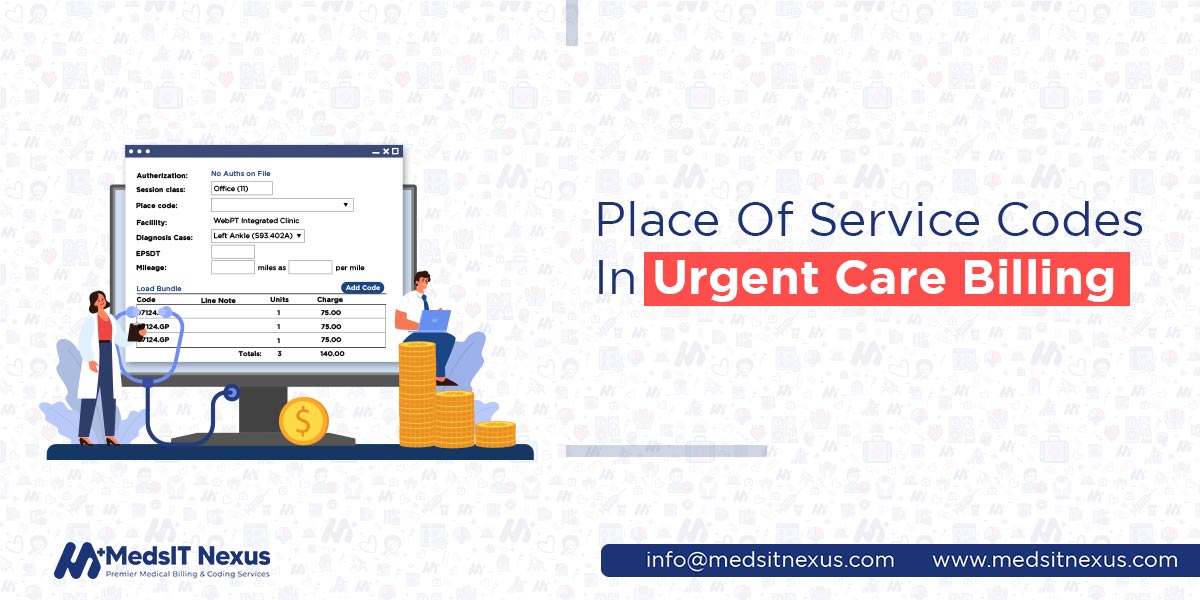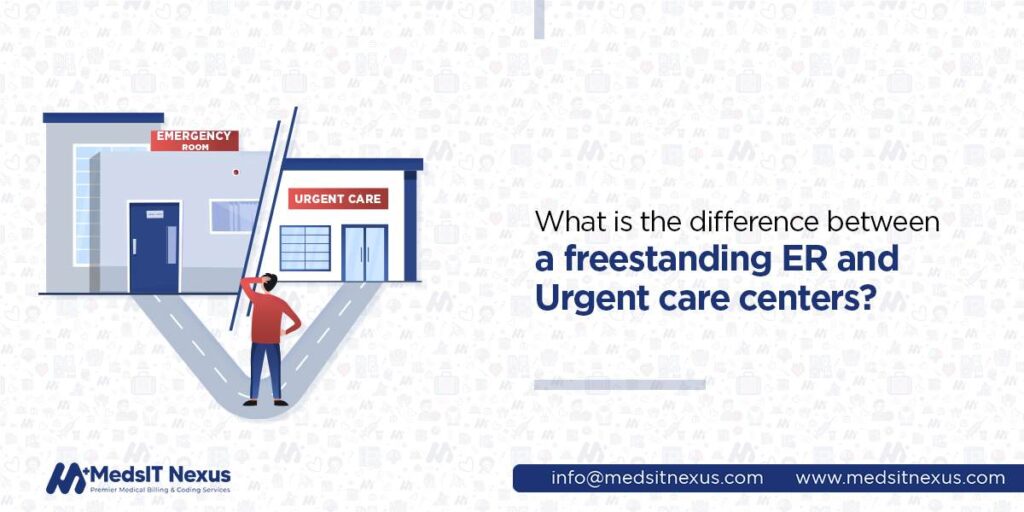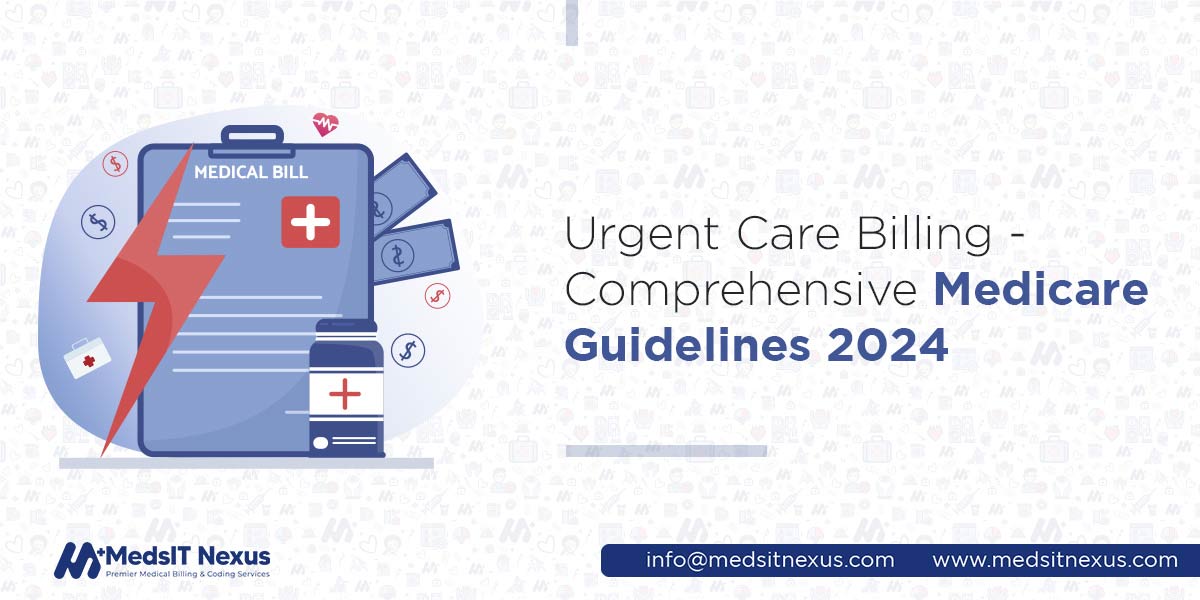Place Of Service Codes In Urgent Care Billing

Medicare claim form CMS 1500 has a dedicated field for the POS code to be filled for processing. On this particular code, the reimbursement rates need to be initiated once the actual settings where the beneficiary receives the face-to-face service are determined through the address and ZIP code of the physician’s practice location, which might be a Facility or a Non-Facility, which are two classifications organized by the CMS. These are the locations where the medical procedures and the services delivered are directly correlated to the standard protocols on which the Centers for Medicare & Medicaid Services or the other private insurers are willing to pay. Facility medical billing is also referred to the terms like institutional and professional medical billing. But, the regulatory bodies aren’t bothered much for this confusion, because they build a standard categorization for the medical facilities with their relevant place of service codes, which you can find in the following table
| Place of Service (POS) | Facility Type | Associated POS Codes |
| Facility | Hospital | 21 |
| Facility | Skilled Nursing Facility (SNF) | 31 |
| Facility | Urgent Care Centers | 20 |
| Facility | Emergency Room | 23 |
| Facility | Ambulatory Surgery Center (ASC) | 24 |
| Non-facility | Physician’s Office | 11 |
| Non-facility | Nursing Facility | 32 |
Understanding the Urgent Care Place Of Service Insurance Reimbursement Work Flow Process
In the above table, the most important place of service codes interconnected to urgent care billing, and
reimbursement are categorized, but more than 50 POS codes are used in filling claims to the
insurance.
The urgent care facility is connected to the other medical facilities, and Non-Facility mentioned in the
above table in a context, depending on the condition of the patients and their treatment requirements,
they can be referred to the other relevant facilities, in some situations, treatment is also delivered
in the Non-Facilities such as a physician office and a clinic, but the matter of fact here is the
insurance collection of the medical providers.
Insurance coverage for the Non-Facilities is much higher than that of the medical facilities (hospital,
ASC, skilled nursing facility, nursing home) because the physicians or medical providers don’t have the
expense for staff, overhead, equipment & supplies used to perform that service when the service is done
in the facility setting.CMS has a physician fee schedule that includes work Relative Value Unit (wRVU),
practice expense (peRVU), and malpractice expense (mpRVU) as the major components, when the service is
performed within a facility, the practice expense relative value unit (RVU) is lower. Majorly, the
facilities have (inpatient department) IPD and (outpatient department) OPD that are formally considered
as the on-campus and an off-campus location of the hospital in the context of the medical billing. The
place of service 22 and a place of service 19 are used distinctly to refer to these locations.
Identifying and selecting the proper POS in the urgent care setting
Urgent Care Center facility is a central entity among ASC, emergency room, hospital, and skilled nursing
facility; patients can be referred to any one of the facilities depending on their situation. Immediate
service can also be provided in the Physician’s office for which the urgent care claims are processed
with the POS 11 acceptable by the CMS regulatory body for processing.
Critical coding scams in using the place of service codes have already been identified by the U.S.
Department of Health and Human Services (HHS) Office of Inspector General (OIG) from the study they
performed last year. As per their demonstration, Place of service codes has truly become a compliance
target, proven by the instances of financial losses that Medicare has made, such as the overpayments of
$33 million to the physicians based on an incorrect POS being listed on the claims. This is mainly due
to using Non-Facility POS code 11 while the services were provided in the facility location (i.e., an
ASC).
This is evidenced by the A/B Medicare Administrative Contractor (MAC) designated by the CMS (Centers for
Medicare & Medicaid Services) that processes Medicare Part A and Medicare Part B claims for the defined
geographic area, hospitals, doctors, practitioners, and suppliers.
In their A/B audits, the payer(auditor) crosses over from an improperly paid professional service to its
matching facility-side service that runs under the MAC compliance risk protocols that match both
professional services to the facility services and calculate overpayment estimates.
In these circumstances, CMS has defined a POS 20, making urgent care centers distinct from other medical
facilities and non-facility locations dedicated to treating unscheduled, ambulatory patients seeking
immediate medical attention.
Difference between the Place of service 20 and place of service 11
The primary difference between the following place of service codes are the locations (Facility or
Non-Facility) where the services are rendered —
For more requirements that need to be added ??
However, further justification is required in this context: the terms and conditions on which a facility
gets credentialed (insurance contract) with the insurer & Payer. If there is nothing contrary in the
urgent care contract language, maximum urgent care facilities bill POS-20 to the payers as of the nature
of urgent care operations, which entails the higher operation cost requiring greater capital and
operating investment. To retain their profitability and sustain operational costs, it is critical to
contract for the higher reimbursement that comes along with billing POS-20.
Still, there are a few circumstances when the insurer accepts urgent care center insurance claims for
reimbursement under POS-11(doctor’s office or clinic), including the following:
- The urgent care market is heavily saturated, such as in Florida and New Jersey. In these areas, situations may occur where the insurance companies may inform the new centers that their network is “full of urgent care” therefore, further applications for urgent care credentialing can not be processed.
- There might be a situation where urgent care operates in an area with fewer primary care physicians, and people rely on urgent care centers to meet their PCP needs. In such a case, urgent care is engaged in a mixed model of UC/PCP to serve more patients in the area. In this scenario, urgent care creates separate primary care (POS-11) contracts with payers. It implements a process to keep apart urgent care(walk-in, episodic) patient traffic from one primary care (scheduled appointments, wellness exams, quarterly follow-up on disease states like diabetes).
Consequences of billing incorrect urgent care POS codes — Reasons to outsource
When physicians incorrectly bill the place of service codes, it results in the denial of the claims when
the audit process is taken into action by the Payer.
Because of claim rejection, reimbursement of the provider gets disturbed, thus decreasing the cash flow
for the medical facility. Implications of the wrong place of services are mainly due to the internal
control weaknesses at the provider billing locations where the physicians needed to implement the
financial risk management controls to identify and prevent the billing with incorrect place of service
codes. Following are a few reasons that cause physicians and their billing personnel to have the wrong
interpretation of the location of services:
- Billing professionals have a lack of knowledge in a precise definition of a “physician office” or other non-facility location or were simply following the established practices in applying the nonfacility codes
- Medical billers are unaware of the standard CMS rules for differentiating in the assignment of the codes for the physician’s office and the outpatient department of the hospital, which causes the increased Medicare payment. This ultimately results in the rejection of the claim as the wrong submission of the POS codes, which are from different places of service rather than the actual ones, comes under the category of false claim submission.
- Billing personnel has made isolated data entry errors
- There are flaws in the design or implementation of billing systems, causing all claims to be submitted with a nonfacility location as a place of service code, which results in the loss of revenue and lower reimbursement of the claims
Under these circumstances, it would be highly beneficial for the urgent care facility to outsource its coding activities to the healthcare administrative partner, ensuring medical billing compliance in your practice revenue management, minimizing financial risks, and assisting you in maintaining a healthy financial position for your urgent care center. MedsIT Nexus's urgent care billing department is equipped with professionals with good experience and expertise in handling data entry workload efficiently, fixing rejected claims, and collecting patient responsibility and insurance follow-up compared to your in-house staff.
Marshall-Russ, Technical Author -
Healthcare IT & Data Systems Analyst at MedsIT Nexus
Edit Technical documentation, workflow automation insights, and data-driven RCM improvement publications following our standard publication protocols.






